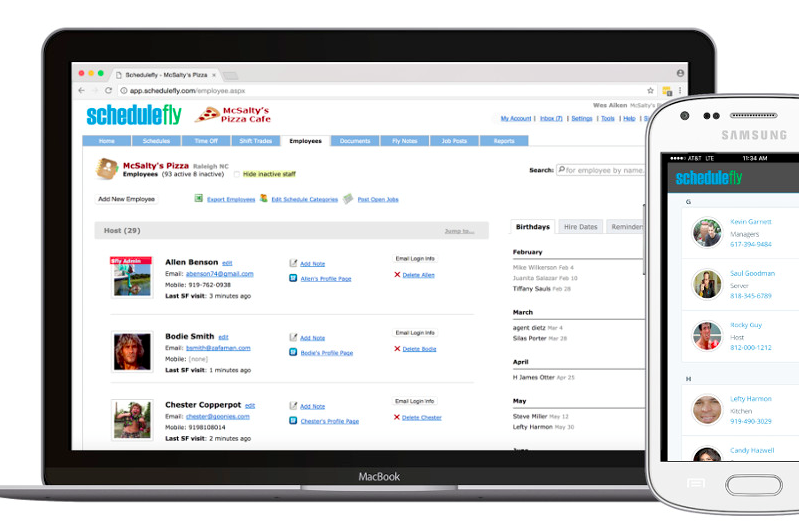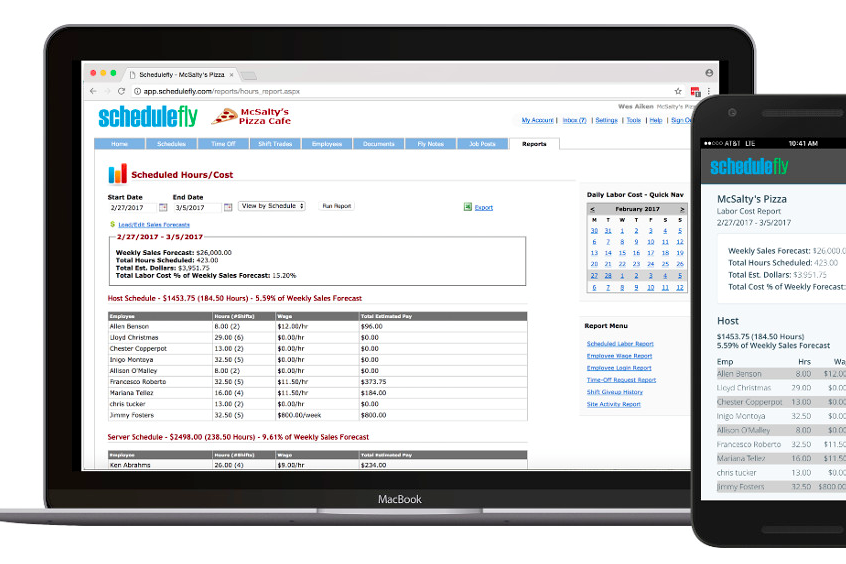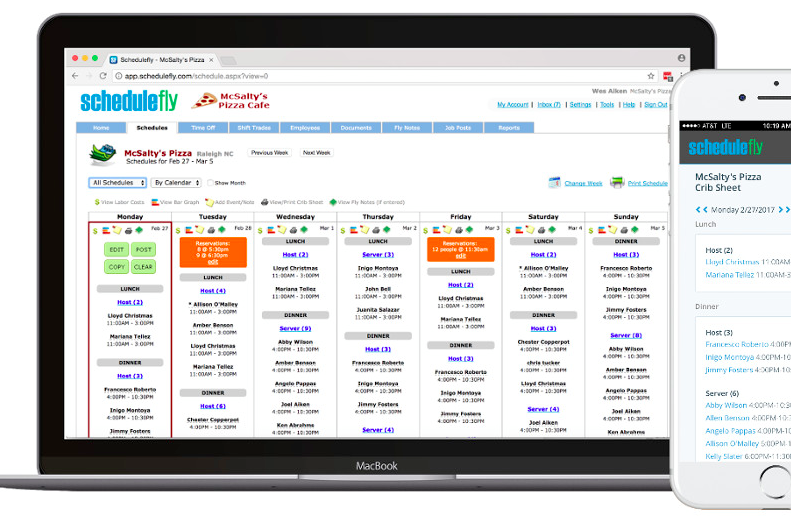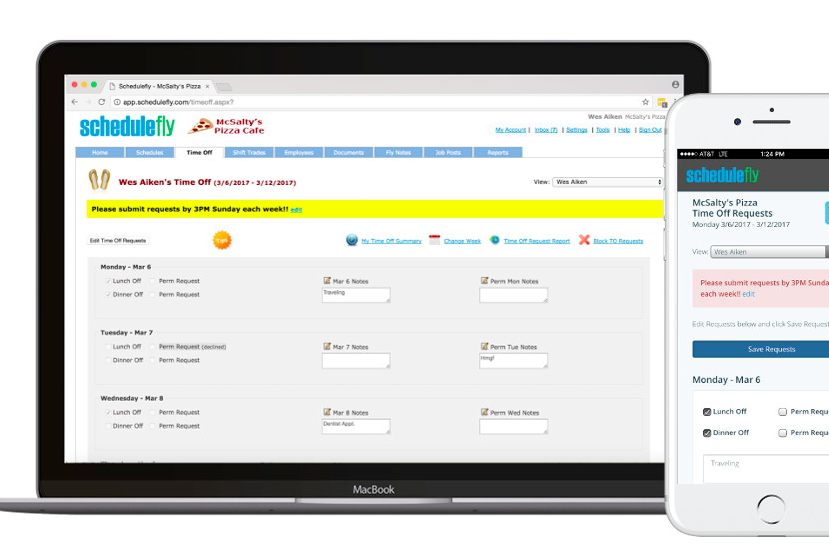Schedulefly is a cloud-based restaurant management software that enables restaurant managers to create schedules, edit them, store them as templates and communicate updates to restaurant employees.
Schedulefly is cloud-based and can be accessed through mobile and computer, meaning that changes to schedules can be communicated to all staff members at all times. This is complemented by a clutter-free interface, which makes tracking schedules, trading shifts, viewing time off and more a simple process. In addition, managers can also receive a daily crib sheet which details the full working day.
Schedulefly can also enable easy communication between managers and employees. Managers can use one-click functionality to send schedules to employees via text and email. In addition, there are Facebook-like message walls, which can be used for business-centric updates and social team-building exercises.
Managers can also take advantage of additional solutions that help make a restaurant much more manageable. With Schedulefly, managers can examine projected labor costs, use job listing tools to hire new employees, store documents such as training manuals, send alerts to employees, set reminders and much more.
Who is Schedulefly for?
With an initial price point of $30 per month for less than 19 staff members, Schedulefly is a suitable option for small and medium sized businesses. It also accommodates larger enterprise-sized restaurants, since Schedulefly has a multi-unit dashboard that keeps managers updated on schedules across a number of their restaurants. In addition, Schedulefly is customizable, allowing managers to create a scheduling system that can fit any given restaurant size.
As of August 2017, Schedulefly is catering to over 7000 restaurants across the USA.
Core functionality
The dashboard is intuitive and free from clutter, making it very easy to navigate. It comprises of five sections: Home, Schedule, Time-Off, Shifts Trades, Employees, and Docs/Photos.
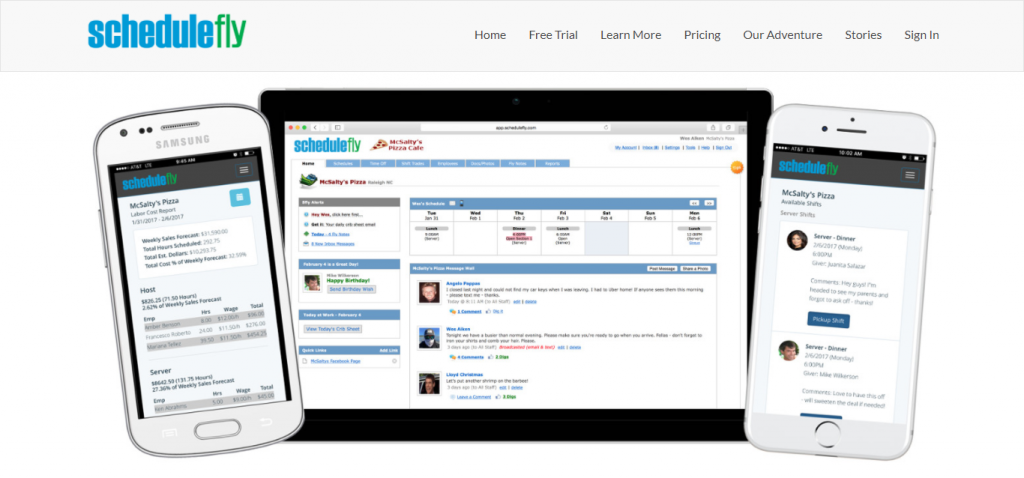
Home
Home gives restaurant managers an immediate snapshot of the day ahead. The left side of the screen contains an alert box, which relays important information that may require immediate attention, such as a shift being canceled, or inbox notifications.
In addition, Home also features a message wall (akin to Facebook) so managers and employees can easily broadcast messages which can be viewed by anyone on the team. In conjunction with important business-centric messages, the message wall can also be utilized to foster friendly team-building conversations among employees.
The message wall is intuitive, with user access management functionality for restaurant managers to ensure only relevant members of the team see the messages posted. Managers also have the ability to broadcast messages to employees via email and a text, ensuring that nobody will miss them.
Scheduling
For managers, creating a schedule is a simple process. It comprises of creating a shift timeslot (such as lunch or dinner) and adding employees into the shift. There are more complex functionalities if managers want to get a bit more organized. For example, they can create shifts for a specific job role such as a bartender or chef.
The schedule puts ease of use at the forefront of the user experience. There is a ‘copy’ tick box that copies and pastes the same schedule for the rest of the week, depending on which days have been selected.
What’s more, the system is context sensitive. It tabulates individual employee working hours and the overall labor costs as managers assign shifts to employees. This feedback is valuable for managers self-assessing their scheduling efforts as they make adjustments.
Additionally, the schedule is smart enough to let managers know of any issues that may arise when assigning shifts. For example, identifying overlapping shifts or employees that are off on a specific day can easily be ascertained (by a red exclamation mark, so you don’t miss it).
The schedule itself is very easy to read. The whole month can be displayed on one page, which is a welcome addition as it mitigates needless clicking between individual weeks. As seen in the picture below, each time slot is attached to an individual employee. Clicking on an employee’s name causes a helpful toolbox to appear and in the toolbox, managers can find handy information such as emails and phone numbers should someone need to contact them. Again, the fact that this information can be obtained without specifically accessing the employee’s profile page is a welcome design choice.
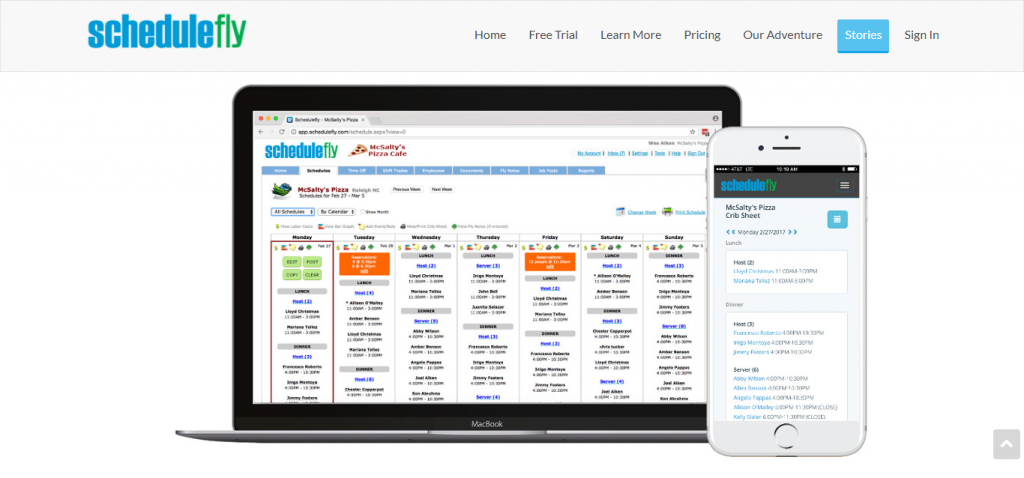
Furthermore, days that have been marked orange convey there is an event on that particular day. As one would expect, managers and employees can also access a schedule calendar which provides an avenue to view previous and future schedules.
And lastly, there are handy graphs embedded within each timeslot, which give visualizations of an employee’s work hours on a particular day.
Employee Database
The Employees tab contains a database of all of the staff members. Phone numbers, working hours, notes, emergency contacts and a lot more can be accessed from here. A universal search box enables managers to quickly search for employees by name, substantially shortening the time it can take to find an employee.
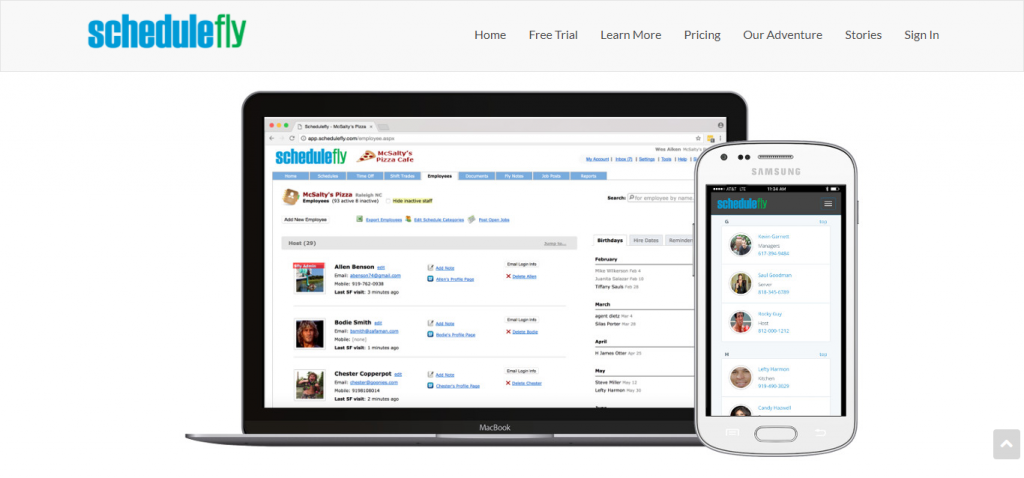
From this section, managers can also add new employees into the schedule, and add notes with sensitive information about existing employees that they will not be able to see. Managers will find this particularly useful to remind themselves of important employee information, such as dietary needs or allergies.
Scheduling and Approving Time-Off Tab
The Time-Off tab is where time-off requests are created, and then approved or denied by a manager.
In addition to the functionality one would expect, there are some time-saving features that are very useful, such as the functionality to select parameter boxes when making a request, such as Day Off, Evening Off, and Permanent Request. This is quite handy for saving time, as it mitigates the need for an employee to repetitively book every day off. For example, if they wish to take every Tuesday off for a whole month.
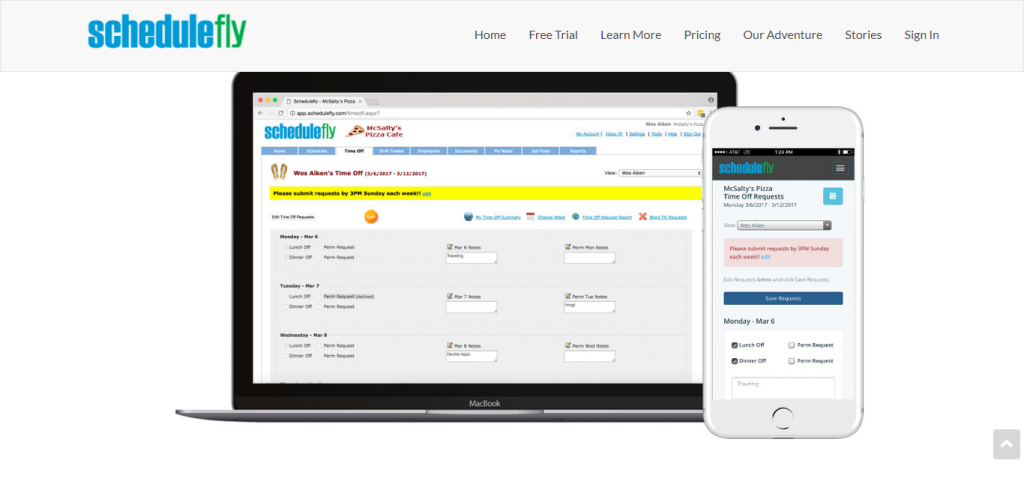
The use of catch-all check boxes can be particularly useful for an employee that has to take a recurring day off every week, for school, childcare or family issues.
Shift Trading
Shift trading is a quick and easy process with Schedulefly. All employees have to do is click on the ‘giveup’ prompt, as seen in the picture below, which is embedded in every time slot an employee is working.
Shift trading is made easier by the functionality that lets employees ask another team member to take their spot. Of course, shifts can also be made available to everyone.
In conjunction, the shift trading tab also contains a section which displays all of the shifts that have been offered up by employees, meaning that anyone can easily ascertain shift availability.
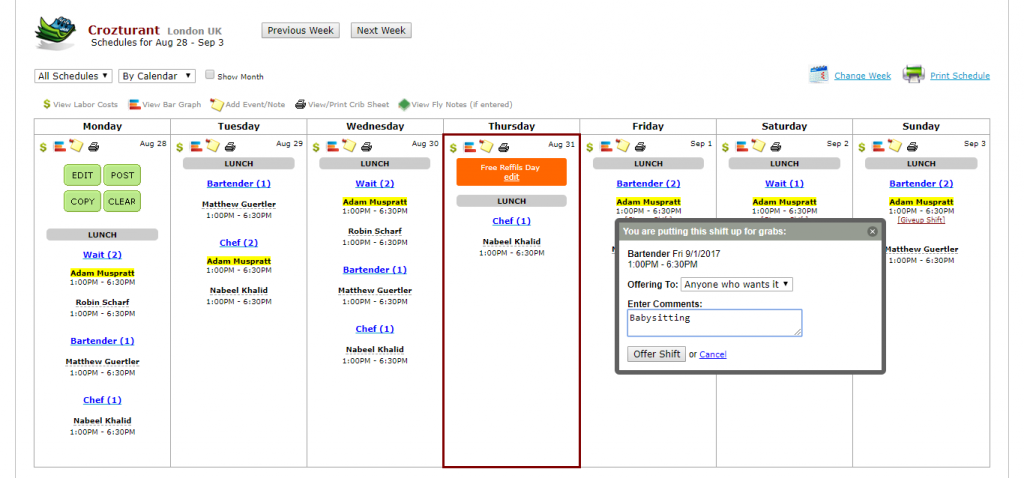
With this system in place, employees and managers would not have to call into their human resources department or call other employees to work out availability, as all shifts are easily accessible online, resulting in a system where shifts can be offered up and taken efficiently.
Job Posting Tools
If managers are looking to hire new staff, Schedulefly contains a few functionalities that can help with the hiring process. Managers can spread their search to the most widely used social media websites such as Facebook and Twitter.
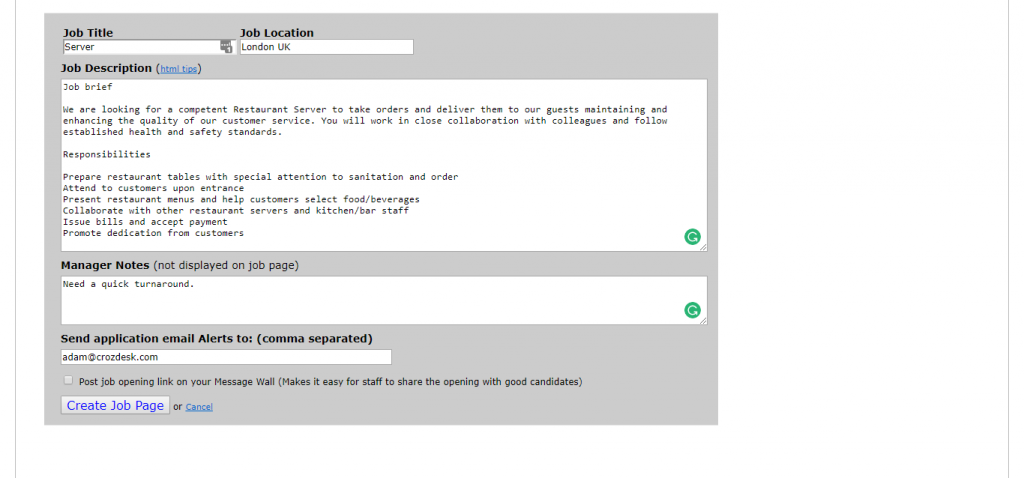
To accomplish this, managers can key the job specifications into the job posting tool, as seen in the picture below, and Schedulefly will post the job on the website. Afterwards, managers can post the link to the job posting on their preferred social media websites.
To further compliment this, Schedulefly stores and tracks resumes when job seekers apply for these jobs, mitigating the need for an HR manager to do additional administration work.
Daily Crib Sheet
A daily crib sheet is emailed to managers every morning. The Crib Sheet contains a list of all of the employees coming in on that particular day, giving managers a snapshot of who is attending upcoming shifts. The crib sheet also has additional information that would be helpful for a manager, such as contact information, employee work timings and even birthdays.
Document Storage
Schedulefly enables managers to store important documents which can be shared with employees. This is useful for files such as training manuals and codes of conduct, or even team photos, all of which can be posted on the comment wall. Additional functionality will also enable managers to specify access levels for specific documents. Overall, this is a great alternative to printing out all of your files and physically handing them to all of the employees.
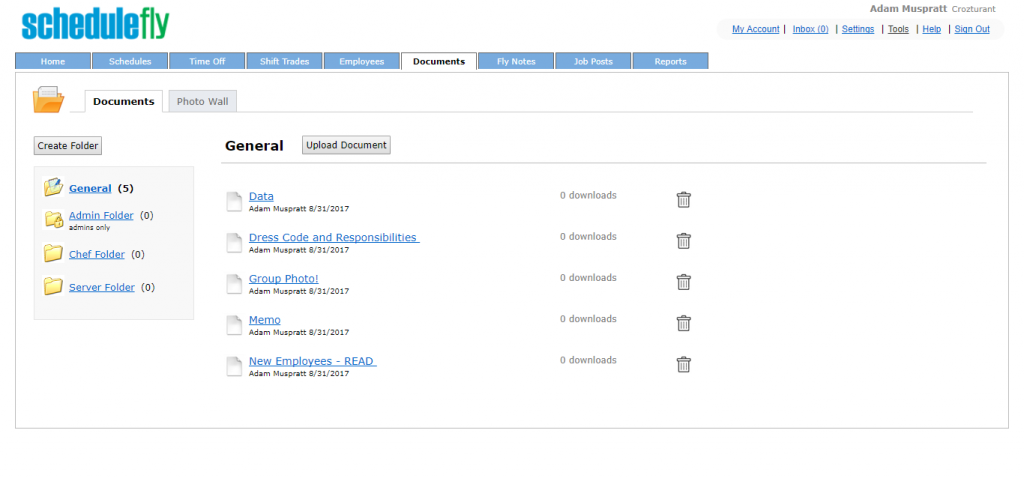
Fly Notes
Say goodbye to paper-based notebooks. For detailed note-taking, Schedulefly offers a solution called Fly Notes. This note-keeping system enables managers to post and share notes with employees, which ensure that events and items have a higher chance of being actioned. For example, if supplies were running low, a note could be created and sent to the employee in charge of logistics and procurement.
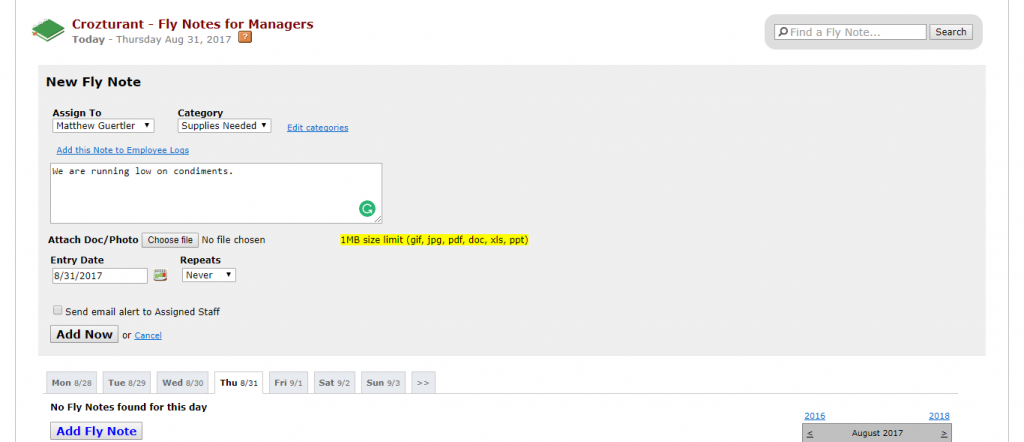
Added functionalities include custom Fly Note categories. Fly Notes can be created specifically for supplies, deliveries, cleaning and any other category that springs to mind. In addition, the recipients of Fly Notes are completely left to the manager’s discretion. Not only can they be created specifically for individuals, but they can also be assigned to employee groups such as chefs and waiters. Lastly, when a Fly Note is published, employee’s associated with it are able to comment freely on it. This ensures that the communication process doesn’t end when a Fly Note is published, giving recipients the opportunity to give updates and ask questions.
Labor Cost Calculator
Managers can keep tabs on their labor costs to make sure that their scheduling efforts are running efficiently. This section gives managers a quick snapshot of projected income and costs of running the workforce. The calculator itself is simple to use – all managers have to do is input the expected sales numbers and the calculator will generate a figure which calculates the costs of labor as a proportion of the restaurant’s overall income from sales.
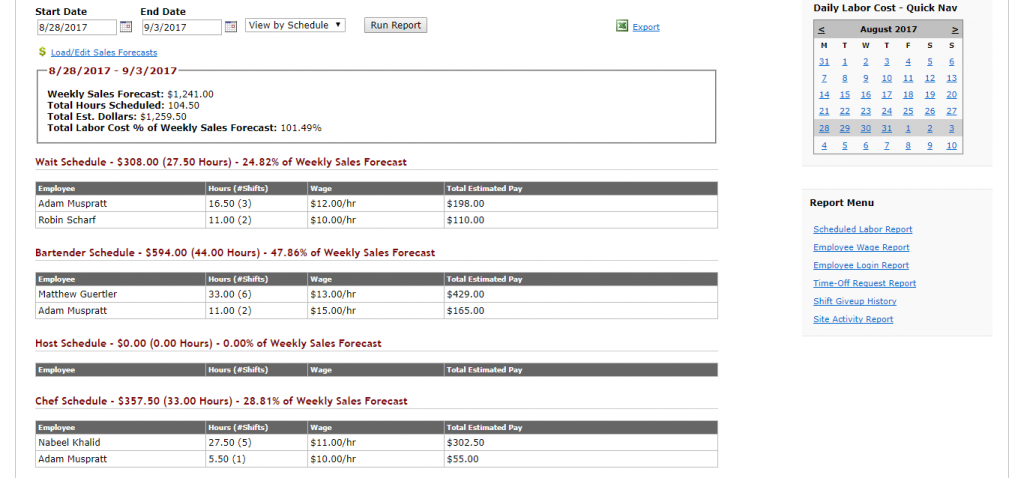
Pricing
Staff of 19 or less – $30 per month
Staff of 20-39 – $50 per month
Staff of 40-59 – $50 per month
Staff of 60-79 – $60 per month
More than 80 staff requires a quote
Schedulefly has a very simple pricing tier where every feature is available in every tier, meaning that managers are not going to be locked out of features for picking the cheapest plan. The only aspect that differs between each pricing plan is incremental increases in the number of staff that can be entered into the schedule.
Furthermore, each plan is paid on a monthly basis, starting off at $30 per month for a staff of 19 or less. From that starting point, it is generally an additional $10 per month for an extra 20 employees. And if a manager has more than 80 staff, Schedulefly suggests that managers should contact the Schedulefly team for a quote.
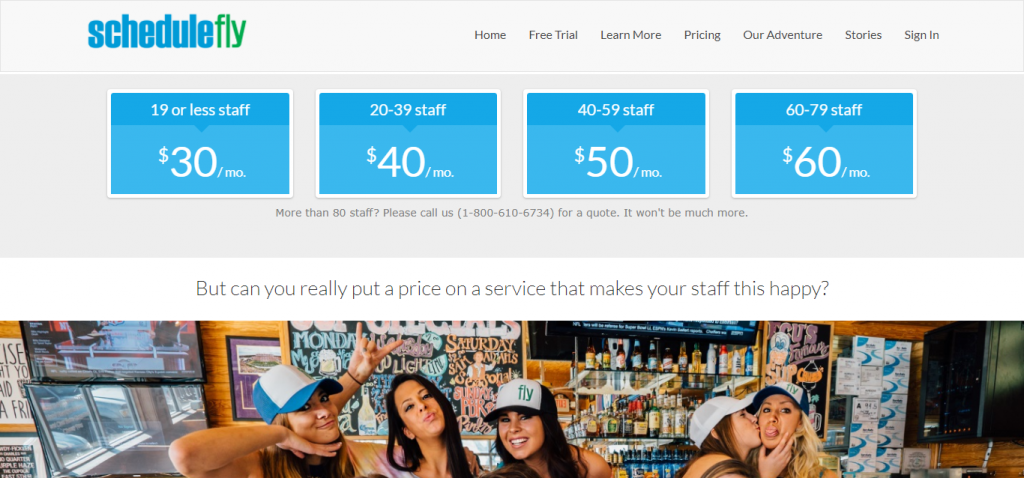
Conclusion
Restaurant managers will be mindful of the time-consuming, monolithic and ever-present task that is employee scheduling. Yet, getting the balancing act of employee coverage correct and ultimately having the ability to schedule efficiently is one of the key determinants of a restaurant’s efficiency. Underfilled schedules may hinder the customer experience, conversely, overfilled schedules may hinder a restaurant’s profits.
All in all, Schedulefly is a great cloud-based solution that helps managers beat the balancing act, ensuring that scheduling is efficient, easy to setup and easy to communicate to employees.
